The Lost Executioner
Grim book tells the terrible tale of Cambodia's slaughter and shame. But it's also a great detective story, as Nic Dunlop seeks and uncovers the Torture King of the Khmer Rouge regime.
By Ron Gluckman /Phnom Penh, Cambodia, and Bangkok, Thailand
FROM THE DEPRESSING GLOOM that perpetually hovers over Cambodia comes yet another book about the unfathomable cruelty of the Khmer Rouge, but one that, at least, does not try to explain the savage orgy of killing that prompted the world to consider a terrifying new concept—autogenocide, the extermination of one’s own people.
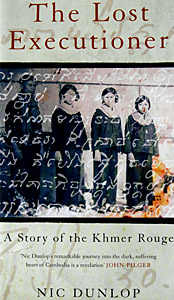 Nic Dunlop, an Irish photographer who spent much of his career in Cambodia,
has many questions, and considerable insights to the madness. Yet, he takes a
novel approach, focusing on one principal in the nightmare that came to be known
as the Khmer Rouge.
Nic Dunlop, an Irish photographer who spent much of his career in Cambodia,
has many questions, and considerable insights to the madness. Yet, he takes a
novel approach, focusing on one principal in the nightmare that came to be known
as the Khmer Rouge.
His subject is Comrade Duch (pronounced Doik), the mysterious commander of S-21, a secret prison camp the likes of which the world has—thankfully—rarely seen. Some 20,000 men, women and children were dispatched to a former school in Phnom Penh also known as Tuol Sleng (and still today, as a museum to the Cambodian holocaust); only seven walked out alive.
The rest were brutally tortured, then dispatched to the infamous Killing Fields, where they were clubbed to death by direct order of the mysterious Duch, of whom the world knew nothing, not even his true name.
After the fall of the Khmer Rouge, Duch disappeared, seemingly burying the secrets of S-21 as effectively as its tens of thousands of victims. Until Mr. Dunlop caught his scent.
Mr. Dunlop would seem an unlikely angel of accountability. He was not yet 10 years old when the Vietnamese invaded Cambodia, ending the brief but incomparably cruel Khmer Rouge reign. Some two million Cambodians were put to death, a full third of the population. Included were virtually all doctors, lawyers, teachers, even students.
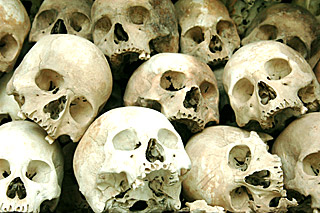 In percentage terms, he writes, the genocide
was worse than that wrought by the Nazis and the Rwanda regime combined.
In percentage terms, he writes, the genocide
was worse than that wrought by the Nazis and the Rwanda regime combined.
Others have recounted the madness, much earlier and in greater detail. David Chandler has practically made a career out of documenting Cambodia’s tragedy, while journalists from John Pilger to Elizabeth Becker have produced insightful books.
Mr. Dunlop’s approach is different from these writers, partly because he’s a photographer. At times, his style lacks sophistication. Yet, there is a freshness to the rough approach of someone whose career has been spent capturing images.
He can be raw, crude, but brutally evocative. Talking to former Khmer Rouge who joined as student idealists only to suffer greatly in the intellectual purges later, a woman recalls a younger brother, killed by the Khmer. "He once told me, you can talk about the Khmer Rouge, but you cannot cry."
Why not, I asked. She paused, "because there would be no stopping."
Ultimately, what makes this book unique isn’t the story of how Mr. Dunlop tracked down, unveiled and reported the confession of Cambodia’s Lost Executioner. All thrilling details, to be sure.
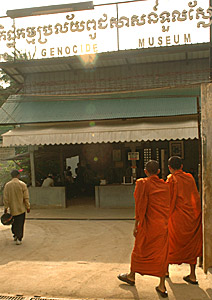 But at its essence, this isn’t
so much a book about Cambodia, or the evils that occurred under the Khmer Rouge,
or why (although all of this eats Mr. Dunlop, filling the pages).
Rather, it’s
a tale of a tiny country that grabs the attention of a man from the other side
of the globe, becoming his obsession. Rather than detective story, it’s one of
self-discovery.
But at its essence, this isn’t
so much a book about Cambodia, or the evils that occurred under the Khmer Rouge,
or why (although all of this eats Mr. Dunlop, filling the pages).
Rather, it’s
a tale of a tiny country that grabs the attention of a man from the other side
of the globe, becoming his obsession. Rather than detective story, it’s one of
self-discovery.
In an interview, Mr. Dunlop tells me: "The Khmer Rouge represented the first time, as a child, I realized how horrible the world really was." Duch represents his own heart of darkness.
Mr. Dunlop was initially keyed to the chase by a series of photographs, stark, grim portraits of every person who passed through S-21.
These were taken by Neim Ein (among many subjects that Mr. Dunlop tracks down, and interviews), sent to China to train to capture the images of all who were, Mr. Dunlop writes, "processed before being smashed to bits."
The photos were eventually collected in a book, exhibited at New York’s Museum of Modern Art, and remain haunting reminders hanging at S-21, now the genocide museum in Phnom Penh.
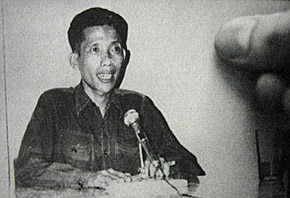 The pictures provide one thread of the book,
which, surprisingly, considering it's by a professional
photographer, contains fewer than a handful of images. One was
a picture of the Lost Executioner, carried by Mr. Dunlop in his wallet for over a decade, allowing
the author to unmask Duch by coincidence in a refugee camp in 1999. Amazingly,
one of the world’s worst killers was working under a new identity as an aid
worker.
The pictures provide one thread of the book,
which, surprisingly, considering it's by a professional
photographer, contains fewer than a handful of images. One was
a picture of the Lost Executioner, carried by Mr. Dunlop in his wallet for over a decade, allowing
the author to unmask Duch by coincidence in a refugee camp in 1999. Amazingly,
one of the world’s worst killers was working under a new identity as an aid
worker.
Remarkably, this astonishing scoop isn’t the end of the story. Mr. Dunlop does a credible job of not only of tracking down Duch, but also detailing his early life, from privileged youth to dedicated school teacher, like many senior Khmer Rouge. What he cannot explain is what turned the former teacher into torturer.
Mr. Dunlop concedes a certain despair in the lack of resolution, not just in the case of Duch (currently in jail, among the only pair of prominent Khmer Rouge likely to face trial if the endlessly-discussed Cambodian tribunal ever takes place), but also in reconciliation for Cambodia.
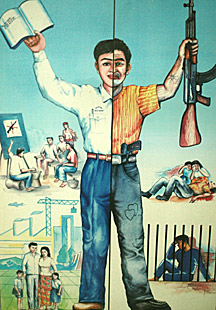 Mr. Dunlop thinks that
must take place for the sake of all the victims and human-rights workers who
populate these pages.
Mr. Dunlop thinks that
must take place for the sake of all the victims and human-rights workers who
populate these pages.
But there is also a lack of resolution for Mr. Dunlop himself, and humanity, too. The author is blisteringly unsympathetic in his views on the entire aid effort that spent then-record sums to solve Cambodia’s misery, to little avail.
He also writes venomously about the various political forces that funded and armed the Khmer Rouge, and kept them in power to kill longer.
Nor is he easier on himself, or his profession. "As I took pictures of the pictures," he writes, "I realized I was participating in another person’s sufferings and vulnerability and exploiting their memory still further and for much more nebulous reasons."
"There is a need among photojournalists (myself included) to justify what we do," he writes. In the end, he cannot.
"It was at times like these, several years after Duch’s imprisonment, that I began to question my own role in his incarceration and what purpose it has served other than to shut him up.
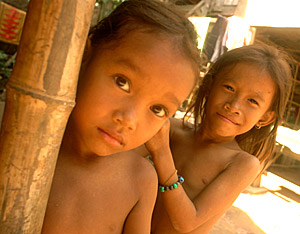 "By seeking out Duch, confronting him and
then publishing the contents of his confession with his picture, I had naively
believed that the truth about the killings would be made known, that a real
justice would be forthcoming and other former Khmer Rouge brought to
account."
"By seeking out Duch, confronting him and
then publishing the contents of his confession with his picture, I had naively
believed that the truth about the killings would be made known, that a real
justice would be forthcoming and other former Khmer Rouge brought to
account."
None of that has happened, of course, and that remains a tragedy both for Cambodia and the concept of international accountability. All that we have to show for the chase then, is this book.
Mr. Dunlop, who immersed himself in so much of Cambodia’s sorrow, may not think this much, but it’s a remarkable contribution.
Ron Gluckman is an American reporter who is based in Bangkok, but roams around Asia for a number of publications, such as the Far Eastern Economic Review (www.feer.com) which ran this book review in the June 2005 issue.
All pictures by Ron Gluckman.
To return to the opening page and index

push here
[right.htm]